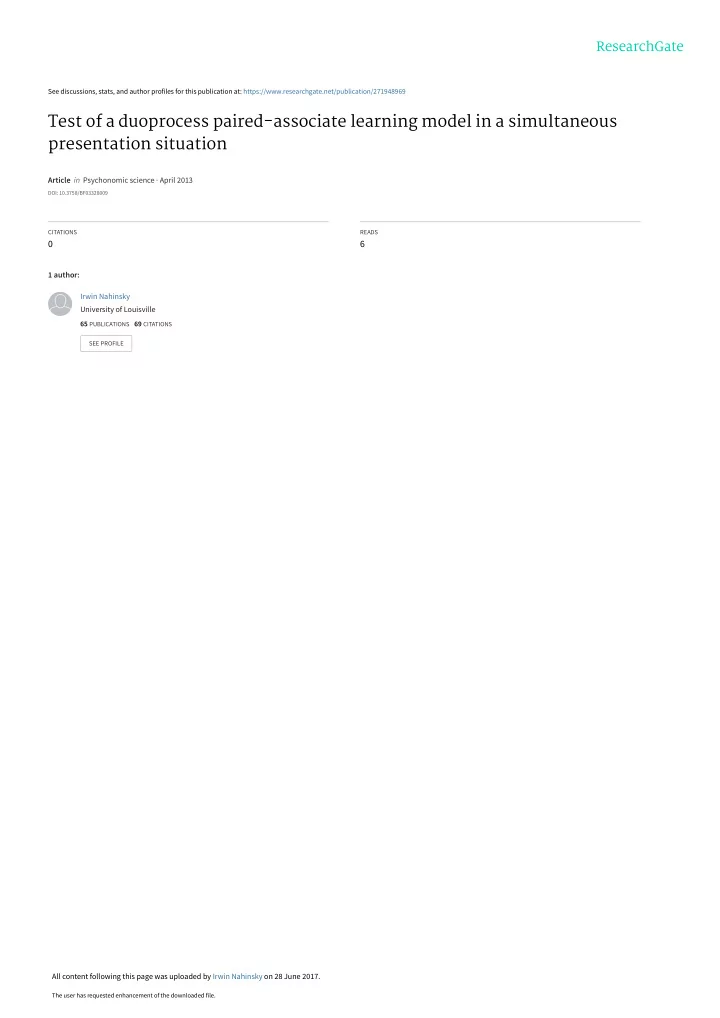

See discussions, stats, and author profiles for this publication at: https://www.researchgate.net/publication/271948969 Test of a duoprocess paired-associate learning model in a simultaneous presentation situation Article in Psychonomic science · April 2013 DOI: 10.3758/BF03328009 CITATIONS READS 0 6 1 author: Irwin Nahinsky University of Louisville 65 PUBLICATIONS 69 CITATIONS SEE PROFILE All content following this page was uploaded by Irwin Nahinsky on 28 June 2017. The user has requested enhancement of the downloaded file.
Test of a duoprocess paired-associate learning model in a simultaneous presentation situation IRWIN D. NAHINSKY UNIVERSITY OF MISSOURI The predictive powers of two all-or-none PA learning mod- the same specified random order on each trial. S was told that the task involved finding the right number els were tested. in a simultaneous presentation situation. A between 1 and 8 for each stimulus and placing that duoprocess model which assumed all-or-none elimination of number in the blank next to the syllable. He was told errors proved superior to the model which did not postulate that each number could be used as an R to any number error elimination. A tendency to match each alternative to one of stimuli or to no stimuli. Each S was instructed stimulus was found. specifically to learn the correct associations as quickly Nahinsky (1964) has developed an extension of the one- as possible. After S filled out a sheet, E marked the element stimulus-sampling model for paired-associate correct Rs "OK" and marked nothing for other Rs. S (PA) learning (Bower, 1961). This duoprocess (DP) was allowed to inspect his corrected paper for 20 sec. model postulates a one stage elimination of incorrect between trials. Rs in addition to the one stage learning of correct Rs Group II (negative feedback condition): This group assumed by the uniprocess (UP) Bower model. consisted of 16 university students. The conditions Most studies of PA learning which involve tests of duplicated those for Group I, except that Ss were mathematical models use the successive presentation instructed specifically to eliminate wrong Rs as well method. The present experiment involves a simultaneous as to learn correct Rs. Here E marked wrong Rs with presentation technique with fixed order of trials which a red check and marked nothing for correct Rs. maximizes possible interactions among stimuli during Results and Discussion learning. Both positive and negative feedback conditions Estimates of parameters outlined in the models were were used. Because both models postulate that single made from the data for both conditions. The values of S-R associations are learned independently of one c for both models were estimated from the average another, departures from predictions of the models in number of errors over Ss in each condition (see Bower, this simultaneous presentation situation may help us 1961; Nahinsky, 1964). An empirical estimate of c to gain insight into the nature of interdependencies relevant to the theoretical comparison can be derived among stimuli in a list. from the all-or-none assumption common to both A brief summary of assumptions of the DP model is theories. This assumption suggests that we consider an in order. Consider the PA situation in which S must R conditioned for a stimulus on the trial after the final learn a correct R from k possible alternatives for each error and one subsequent correct R. Since correct re- of a number of stimuli. The model assumes: sponding invariably follows the correct R, we might 1. The probability of a correct R for each stimulus assume the R is conditioned on that trial. By taking the is 11k initially with probability c of being learned upon ratio of associations to be learned to total correct Rs occurrence after which it always occurs to the stimulus. during these unlearned association trials, we get an 2. The probability of an incorrect R for a given estimate of the probability an association is made when stimulus is (k-1)/k initially, with probability c of being the correct R occurs, Le., an estimate of c. This may eliminated permanently upon occurrence, after which provide a slight overestimate of c, because of chance the correct R probability jumps to 1/(k-1). There are correct responding after the estimated learning point. corresponding jumps in correct R probability with Nevertheless, the estimate illustrates some points of each successive incorrect R elimination. interest. Experiment Two groups of Ss learned Rs to a set of eight CVC trigrams. The trigrams were selected randomly from Table 1. Comparison of Uniprocess and Duoprocl'ss Models a list having 20% association value as determined by for Predictive Power of Parameter Estimates (N=34) Glaze (1928). The vowel E appeared in three syllables, Empirical Un iprocess Duoprocess A in two syllables, and the other three vowels in one Variable estimate prediction prediction syllable each. No syllable had more than one letter in .687 1.240 .620 c common with any other syllable. A pasteboard screen Total proportion of correct separated E and S from each other's view. The learning Rs to total Rs for unlearned criterion for each group was two consecutive cycles .205 .125 .222 association trials of correct Rs for all stimuli. Total number of correct Rs Group I (positive feedback condition): Each S in this for unlearned association 12.90 trial s M=11.65 7.10 group, consisting of 18 university students, was pre- SDM= 1.20 sented with a sheet containing all of the syllables in Psychon. Sci., 1966, Vol. 6 (4) 165
Recommend
More recommend